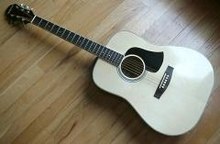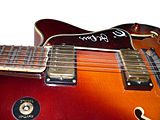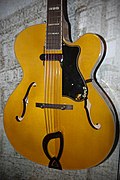
A pickguard (also known as a scratchplate) is a piece of plastic or other (often laminated) material that is placed on the body of a guitar, mandolin or similar plucked string instrument. The main purpose of the pickguard is to protect the guitar's finish from being scratched by the nails of the picking hand, as it was included on guitars not played with a plectrum. The pick does not normally contact that part of the guitar when used correctly.
As well as serving a practical purpose, the pickguard may also be used for decoration and is often made in a contrasting color to that of the guitar body (popular variants are white pickguards on darker guitars and black pickguards on lighter guitars). As well as plastic, other pickguard materials can include acrylic glass, glass, plywood, fabrics, metal, and mother-of-pearl/pearloid varieties. Expensive guitars may have luxury pickguards made from exotic woods, furs, skins, gems, precious metals, Mother of Pearl and abalone pearl.
The pickguard is a very common site for an autograph, since the signed pickguard can easily be detached and moved to another guitar or sold separately as a piece of memorabilia.
Pickguard types
Pickguards come in various designs and shapes but designers usually try to match a headstock and pickguard design. Both can be used to incorporate logos, branding and/or elements of the manufacturer's/customer's style.

Acoustic guitars
Aggressive strumming with a pick can easily damage the polished surface of the guitar's soundboard. Pickguards fitted to acoustic guitars are usually made from thin (2 mm) sheets of plastic (such as PVC), attached with an adhesive just below the sound hole. The material should not be unduly thick or heavy since this might reduce vibration of the soundboard and alter the tone or volume of the instrument. Although not a job for the novice, a badly scratched pickguard could be removed and replaced by a guitar technician or luthier. On some older Martin guitars it is quite common to see the black pickguard curling up at the edges where the adhesive bond between the plastic and the wooden top has broken down. This does not usually present a problem and adds to the "character" of the instrument.

Solid-body electric
Fender-style plastic pickguards are usually fitted on solid-bodied electric guitars such as the Fender Stratocaster and Fender Telecaster (and their many replicas) and often cover a large area of the top surface, because Fender guitars are front routed. Most of the guitar's electronic components (pickups, potentiometers, switches and wiring) are mounted on or behind the pickguard and this design simplifies repairs to the wiring once the pickguard is removed. On models with smaller pickguards, access to electronics on solid-body guitars are usually done through access panels built into the rear of the guitar.

Floating pickguards
Carved-top solid-body guitars, including electric models such as the Gibson Les Paul, and arch-top hollow-body guitars, such as the Gretsch Chet Atkins Country Gentleman use a "floating" pickguard: the plastic pickguard is usually elevated on adjustable metal support brackets. This design was introduced by Gibson in 1909 for its arch-top acoustic models such as the Gibson L-1. It allows the height to be adjusted to suit the guitarist's playing position.
The floating pickguard style is also popular on mandolins, mandolas, and other members of the mandolin family.

Materials
While custom pickguards are made from variety of materials, most mass-production manufacturers use various plastics. The following are the most common:
- Celluloid. Commonly associated with vintage guitars, this plastic is available in variety of colors and designs, but it has several cons that hinder its usage nowadays:
- This material is extremely flammable. Performers who smoke near their instruments with celluloid pickguards can occasionally put everything on fire with a misplaced cigarette.
- As a solvent based plastic, celluloid tends to shrink over the years, making the pickguard curl around the edges. It puts extra stress on the wood beneath the pickguard and sometimes cracks appear. This is very common on older Martin acoustic guitars. On electric guitars, where the pickguard is attached with screws, vintage celluloid pickguards tend to develop cracks due to stress caused by shrinking.
- Vinyl (PVC). This material does not tend to shrink and is not highly flammable.
- Acrylic glass.
Custom designs
The pickguard on a solid-bodied electric guitar is a popular item to be modified (modded) by enthusiasts wanting to add creative designs or use different materials. Several businesses now offer custom-made replacement pickguards to give an instrument a unique look.
The pickguard is sometimes deliberately omitted from a guitar's design. For example, superstrats with neck-thru designs aim for maximum sustain and tend to have no plastic parts, pickup frames or plastic potentiometer handles. Anything that it is imagined might dampen the sound is stripped off the guitar.
Classical and flamenco guitars
Classical guitars rarely have a pickguard since they are usually finger-picked and so are not subject to pick damage.
Golpeador
The golpeador or "tap plate" on flamenco guitars is not a pickguard, although it is sometimes called that by those unfamiliar with the instrument or the flamenco style. The golpeador is specifically installed to provide a stable surface for the heavy percussive tapping and striking with the fingers and fingernails, which are a regular feature of flamenco music. The golpeador (unlike a pickguard) is often fitted both above and below the soundhole.

References
- Pickguard in Illustrated glossary at FRETS.COM Archived 2006-02-15 at the Wayback Machine
- Fingerrest in Illustrated glossary at FRETS.COM Archived 2005-11-30 at the Wayback Machine
- Pickguard colors and materials chart at Warmoth